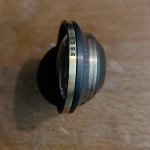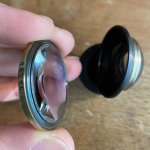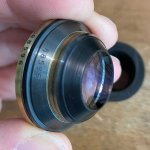james.liam
Well-known
What should one expect a clean CZJ 50/2, perhaps single-coated, go for? I know that's tough to find a minimally scratched one after all these years because of the soft front element.
raid
Dad Photographer
I paid $135 for a very clean one in Contax mount. I was lucky. Someone at ebay claimed that the lens was used by his father, and I bought the lens as it looked clean to me from his ad.
raid
Dad Photographer
Raid, I think that it was all of the above! That was a long time ago though, so I could be mistaken.
No, you could be right
I can remember it. It may have been 14 years ago or so.
It was a complex project where about 20 lenses were sent to me, and I needed to keep track who sent me which lens and with which front/back covers or accessories.
james.liam
Well-known
I paid $135 for a very clean one in Contax mount. I was lucky. Someone at ebay claimed that the lens was used by his father, and I bought the lens as it looked clean to me from his ad.
What's the filter size on the 50/2?
raid
Dad Photographer
I need to check it:. Most likely it is 43mm.
What should one expect a clean CZJ 50/2, perhaps single-coated, go for? I know that's tough to find a minimally scratched one after all these years because of the soft front element.
Patience required to get a clean one. About $150 in Contax mount, coated "T" version is uncommon. The vintage Zeiss 50mm Sonnars take 40.5mm screw in filters, the oldest made 1932~1934 use push on filters only. The Nikkor 5cm F1.4 uses 43mm filters, the Nikkor 5cm F2 and 5cm F1.5 (RARE) use 40.5mm filters.
I have a clean 5cm F2 Sonnar "T" that I converted to Leica mount. I use the 1934 uncoated lens more often. I use it more than the Nikkor 5cm F2.
The post-war 50mm F1.5 Sonnar, on my modified Nikon S2. Camera is custom shimmed and RF adjusted for Contax.

Wide-Open, same girl.

Wide-Open, same girl.
boojum
Mentor
Per TenEleven's earlier post, Walker Evans (as in his sneaky subway shots), Ansel Adams (when he deigned to use 35mm), & Gordon Parks are just a few other Contax users. I think Contax may have been the "house" system at Life magazine.
FWIW, back in '53 or '54 a had a schoolmate who got a lackey intern job at LIFE during the summer break. He had a IIIf at the time. And he shared with me that the LIFE team which went to cover Korea all went with Leica cameras and Leica lenses. They all came back with Leica cameras and Nikon lenses. That was a long time ago and I was inching along with the camera in my icon, a Voigtländer Vito II.
He also said that LIFE got samples of every Kodak color batch. If they liked the batch they bought all they could and stashed it in a freezer.
james.liam
Well-known
Patience required to get a clean one. About $150 in Contax mount, coated "T" version is uncommon. The vintage Zeiss 50mm Sonnars take 40.5mm screw in filters, the oldest made 1932~1934 use push on filters only. The Nikkor 5cm F1.4 uses 43mm filters, the Nikkor 5cm F2 and 5cm F1.5 (RARE) use 40.5mm filters.
I have a clean 5cm F2 Sonnar "T" that I converted to Leica mount. I use the 1934 uncoated lens more often. I use it more than the Nikkor 5cm F2.
When did they start receiving coatings? After the war?
furcafe
Mentor
FWIW, back in '53 or '54 a had a schoolmate who got a lackey intern job at LIFE during the summer break. He had a IIIf at the time. And he shared with me that the LIFE team which went to cover Korea all went with Leica cameras and Leica lenses. They all came back with Leica cameras and Nikon lenses. That was a long time ago and I was inching along with the camera in my icon, a Voigtländer Vito II.
He also said that LIFE got samples of every Kodak color batch. If they liked the batch they bought all they could and stashed it in a freezer.
It's quite possible that Life had partially switched to Leica by the Korean War since the new W. German Contax IIa/IIIa bodies weren't widely available. IIRC, Marc James Small of the Zeiss Ikon Collectors Group wrote that Life donated much of their pre-WWII Contax gear to Alfred Gregory, official photographer of Edmund Hilary's Mt. Everest expedition.
When did they start receiving coatings? After the war?
Zeiss started applying coatings in 1936. My 1940 5cm F2 Sonnar "T" is fully coated. My 1938 5cm F1.5 Sonnar and 3.5cm F2.8 Biogon are both marked "T".
dexdog
Mentor
I agree with Brian that Pre-WW2 or early wartime coated 50/2 lenses are hard to come by, I have one in 268 series that dates to 1940. The other ones both rigid and collapsible are all uncoated, including this one that Brian swapped into a J-8 barrel about 10 years ago. Can't really tell from this pic because I don't have adequate light at my desk at night, but the glass is really nice. I shoulda blown the dust off before taking the shot. I will never sell this lens, it's a beauty


james.liam
Well-known
FWIW, back in '53 or '54 a had a schoolmate who got a lackey intern job at LIFE during the summer break...... he shared with me that the LIFE team which went to cover Korea all went with Leica cameras and Leica lenses. They all came back with Leica cameras and Nikon lenses.
In an odd way, we have Nikon to thank for the Leica 50 Rigid; had the Nikkor 5cm/1.4 not been as acclaimed a lens as it turned out to be, Leica might not have been so hell-bent on catching up with them.
raid
Dad Photographer
My CZJ 5cm 2 seems to be coated.
It has a similar SN as dexdog's lens above.
Is my lens a genuine CZJ?
Why is some of the lettering in color? Is this a J-8, sold as a CZJ lens?
Could it be an experimental lens or somehow a lens that got such colors in the lettering?

It has a similar SN as dexdog's lens above.
Is my lens a genuine CZJ?
Why is some of the lettering in color? Is this a J-8, sold as a CZJ lens?
Could it be an experimental lens or somehow a lens that got such colors in the lettering?

raid
Dad Photographer
Could it be that someone took a czj and colored the lettering and then added multicoatibg?
There are no collapsible J-8 lenses!
Could my lens be a real Zeiss lens?
There are no collapsible J-8 lenses!
Could my lens be a real Zeiss lens?
furcafe
Mentor
Could it be that someone took a czj and colored the lettering and then added multicoatibg?
There are no collapsible J-8 lenses!
Could my lens be a real Zeiss lens?
No idea about the colors of the letters on the ring, but it was not unusual for people to get their uncoated lenses single (not multi) coated at independent optical shops after WWII. I have a collapsible c.1937 5cm/2 CZJ Sonnar that was clearly aftermarket coated by a previous owner--there's no "T" & the glass is a shade of blue not found on Zeiss-coated lenses.
TenEleven
Well-known
No idea about the colors of the letters on the ring, but it was not unusual for people to get their uncoated lenses single (not multi) coated at independent optical shops after WWII. I have a collapsible c.1937 5cm/2 CZJ Sonnar that was clearly aftermarket coated by a previous owner--there's no "T" & the glass is a shade of blue not found on Zeiss-coated lenses.
If the serial number range is within 1.89mil to 2.1mil it may very well be Zeiss coated. Especially if the coating color is a very faint blue (the exact hue varies - likely due to age and process imperfections) - it's not an amazing coating but better than nothing. I have a wide range of Zeiss lenses in that exact shade - their manufacture date coincides with the patents and their introduction of a vacuum deposition coating machine.
Further in collapsible Sonnars the front element and middle triplet are permanently bonded to their brass shells - making 3rd party coating efforts - while certainly not impossible - very hard to do - especially without messing up either the bonding or the optical axis. Also the fit and finish of these lens-cups is shockingly beautiful.
I am in fact currently restoring such a Zeiss coated lens. 1.888 Serial


Attachments
furcafe
Mentor
If the serial number range is within 1.89mil to 2.1mil it may very well be Zeiss coated. Especially if the coating color is a very faint blue (the exact hue varies - likely due to age and process imperfections) - it's not an amazing coating but better than nothing. I have a wide range of Zeiss lenses in that exact shade - their manufacture date coincides with the patents and their introduction of a vacuum deposition coating machine.
Further in collapsible Sonnars the front element and middle triplet are permanently bonded to their brass shells - making 3rd party coating efforts - while certainly not impossible - very hard to do - especially without messing up either the bonding or the optical axis. Also the fit and finish of these lens-cups is shockingly beautiful.
I am in fact currently restoring such a Zeiss coated lens. 1.888 Serial
Interesting, the serial number on mine is in the range (203****), but I thought they would have used the red "T" to advertise the process, but maybe that was later. I'll have to take a closer look the next time I dig that lens out
raid
Dad Photographer
No idea about the colors of the letters on the ring, but it was not unusual for people to get their uncoated lenses single (not multi) coated at independent optical shops after WWII. I have a collapsible c.1937 5cm/2 CZJ Sonnar that was clearly aftermarket coated by a previous owner--there's no "T" & the glass is a shade of blue not found on Zeiss-coated lenses.
This is then a possibility that my lens was over the years modified by some people. The chosen lettering looks correct to me.
Share:
-
This site uses cookies to help personalise content, tailor your experience and to keep you logged in if you register.
By continuing to use this site, you are consenting to our use of cookies.



